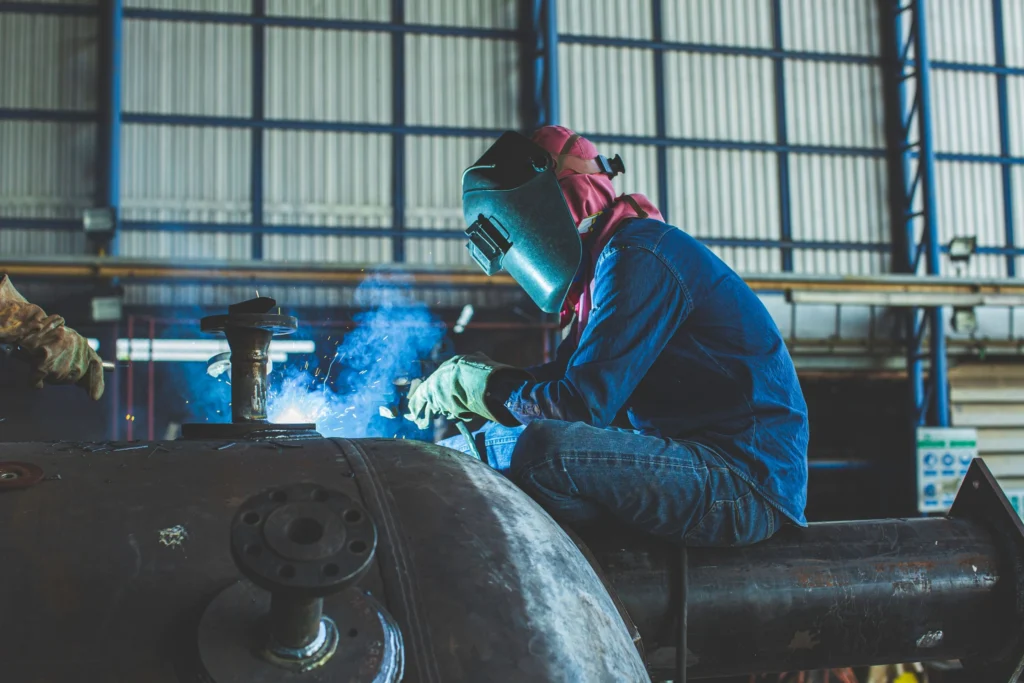INTRODUCTION TO PROJECTION WELDING
Introduction to Projection Welding Machine Training (SA & ST Type) program provides participants with a comprehensive understanding of the principles, operation, quality control, and maintenance of SA and ST type projection welding machines. This course is based on the “Practical Manual of Welding Work: Projection Manual Edition” and is designed to equip trainees with both theoretical knowledge and hands-on technical skills to perform projection welding operations safely and effectively.
Projection welding is an essential process in manufacturing, particularly in the automotive and precision component industries, where high-quality welds are critical for product reliability and structural integrity. Through this program, participants will learn how to manage welding parameters, ensure consistent quality, and maintain optimal machine performance to meet production standards.
LEARNING OBJECTIVES
To provide trainees with a foundational understanding of the principles, operation, quality control, and maintenance of SA and ST type projection welding machines as detailed in the “Practical Manual of Welding Work: Projection Manual Edition”.
COURSE CONTENT
MODULE 1: FUNDAMENTALS OF PROJECTION WELDING
- Topic 1.1: Introduction to Projection Welding
- Definition: A specialized resistance welding method using pressure and current.
- Core Principle: Concentrating current and pressure at specific projections to generate heat and form a weld, known as the “press connection method”.
- How it Works: Converting high primary voltage (e.g., 440V) to low voltage
- (10-30V) and high current (approx. 20,000A) to melt and fuse workpieces.
- Topic 1.2: The Four Pillars of Weld Quality
- A discussion of the four critical factors for a good weld:
- Current Flow Area: How smaller areas increase current density for effective melting.
- Welding Current (KA): The volume of current needed to melt the connection area.
- Current-Carrying Time (Cycle): The heating time required to reach the melting point.
- Welding Pressure: The force applied to suppress the molten pool and prevent material from flying apart.
- Nugget Formation: Understanding the fused area and what constitutes a poor weld.
MODULE 2: MACHINE COMPONENTS AND SYSTEMS
- Topic 2.1: Overview of Machine Types
- Introduction to the SA Piston Rod, SA Lower, and ST Hose Bracket welding machines.
- Highlighting structural similarities and differences between the models.
- Topic 2.2: Key Components and Their Functions
- Electrical System: Timers, contactors, CT (Toroidal) Coils for current detection, and transformers.
- Pressure System: Booster, pressure accumulator, press head, and pressure cylinder.
- Current Path: Secondary conductor, OWNS Copper Plate, upper and lower electrodes (middle/split).
- Cooling System: The importance of water cooling cables and flow meters to manage heat in conductors and electrodes.
MODULE 3: MACHINE OPERATION AND QUALITY CONTROL
- Topic 3.1: SA Machine Operation
- Step-by-step operational flow from parts conveyance to welding and part ejection.
- Understanding the welding cycle: early applying pressure, welding current, and retain applying pressure.
- Topic 3.2: ST Machine Operation
- Unique operational steps: setting the bracket positioner, using magnets for part retention, and the function of the Reject Device.
- Role of the “KOBAM” air intake sensor in detecting improper part positioning.
- Topic 3.3: Quality Control & S Process Management
- Defining “S Process”: Understanding security processes for critically important parts (S classification).
- Worker Requirements: Education and identification for staff working on S processes.
- Initial Quality Checks: Performing visual, hammering, and dimension checks.
- Projection Fit Check: The critical process of using carbon paper to confirm the contact area balance is >80% for ensuring weld strength.
MODULE 4: MAINTENANCE AND TROUBLESHOOTING
- Topic 4.1: Routine Maintenance Procedures
- Importance of daily and periodic checks.
- Cleanliness: Removing spatter and dirt from electrodes and machine attachments during implement changes to prevent sparks and abnormal heat.
Component Inspection:
- OWNS Copper Plate: Inspecting for wear and tear, with a mandatory replacement when the tear limit reaches 25%.
- Pipes and Hoses: Checking for abrasion, holes, or tears from spatter and heat.
- Cooling System: Visually checking the flow meter to ensure proper cooling water volume.
- Topic 4.2: Electrode Care
- Split Electrodes: Cleaning spatter, checking for abrasion, and correcting oxide skin with a brass brush or sandpaper.
- Usage Limits: Emphasizing that electrodes should not be used beyond their defined usage limit line.
- Topic 4.3: Common Failures and Countermeasures
- SA Machines: Troubleshooting issues like Burrs, Burn Marks, Deformation, and Insufficient Strength by verifying current, pressure, time, and electrode condition.
- ST Machines: Addressing failures such as Lean, Dislocation, and Float by checking electrode abrasion, guide plates, and welding pressure.
- Failure Protocol: The rule for stopping the line after 3 consecutive or 5 intermittent failures and contacting a Group Leader.


